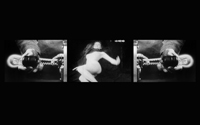
Bruce Conner, THREE SCREEN RAY (composite), 2006; three-channel black-and-white video projection with sound, 5:14 min.; Collection SFMOMA, Accessions Committee Fund purchase; © Conner Family Trust
From January 16 to May 23, 2010, in conjunction with the museum’s 75th anniversary, the San Francisco Museum of Modern Art (SFMOMA) will present the exhibition Long Play: Bruce Conner and the Singles Collection, premiering the newly acquired video installation THREE SCREEN RAY (2006) by the late San Francisco–based artist and filmmaker. A master of a diversity of media and techniques from assemblage to photograms, Conner’s experimental, non-narrative film shorts established him as a leading figure in avant-garde film. SFMOMA’s collection contains Conner’s highly significant work spanning five decades of art making (which will also be highlighted in the concurrent exhibition The Anniversary Show). Throughout the anniversary season, SFMOMA will present a series of exhibitions, including a number of special commissions and acquisitions, under the heading 75 Years of Looking Forward illustrating the story of the artists, collectors, cultural mavericks, and San Francisco leaders who founded, built, and have animated the museum.
Organized by SFMOMA Curator of Media Arts Rudolf Frieling, the exhibition highlights the practice of appropriating sound and images in film and video. Says Frieling, “Bruce Conner’s impact on the way artists are sampling and reworking images electronically and digitally is immense. Long Play recognizes his lasting influence and presents a series of ‘singles’ from the collection that are related to the genre of music video, which owes its energy to avant-garde artists like Conner.”
THREE SCREEN RAY, presented as a premiere in its final museum format, is an extended version of Conner’s second film, COSMIC RAY (1961, black-and-white, 16mm) and EVE-RAY-FOREVER (1965, 8mm), re-edited into three video projections. Like the original single-screen version, THREE SCREEN RAY features a sexually charged, live performance of Ray Charles’s 1959 hit song “What’d I Say” set to an ecstatic, fast-paced collage of preexisting and original imagery, including newsreel footage of bomb explosions, cartoons, television commercials, fireworks, flashing lights, and his signature use of countdown leader. A tour de force of editing and film techniques, the film itself is manipulated by Conner with hole punches and ink stains. The central image is of COSMIC RAY, featuring Conner’s multiple exposures of a woman (Kansas-born artist Beth Pewther) dancing in various states of undress. The painter Joan Brown makes a cameo toward the end in a sequence of stop-motion shots of her donning different hats and accessories: “I felt that I was in a way presenting the eyes for Ray Charles, who is a blind musician. I was supplying his vision,” Conner states.
In 1965, for a solo exhibition at The Rose Art Museum of Brandeis University, Conner exhibited his earliest attempt at an expanded cinema version of COSMIC RAY under the title of EVE-RAY-FOREVER, a film installation of three unsynchronized silent 8mm film loops. In light of the fact that the original exhibition prints were too fragile to be shown and negatives were lost, Conner, in collaboration with his longtime editor Michelle Silva, embarked in 2005 on a restoration project, digitally remixing footage from the 1965 version with other existing copies of 16mm prints and transferring the onto digital video, using synchronous multi-channel editing to arrive at THREE SCREEN RAY, a three-channel video installation with sound to be exhibited in the gallery context.
Acknowledged as the first filmmaker to use pop music for a film soundtrack, prefiguring the music video genre, Conner collaborated with various musicians and composers including David Byrne, Devo, Brian Eno, and Terry Riley. The central dancing figure in THREE SCREEN RAY is echoed by the liberated female subject in BREAKAWAY (1966). Set to the eponymous pop single of Antonia Christina Basilotta (Toni Basil), the five-minute film (included in a video program in the adjacent gallery) features the singer dancing wildly and posing in various outfits, her silhouette starkly contrasted against the black background. Conner’s rapid-fire editing and experimentation with film speed and reversals create an almost spectral image.
Conner’s films have been a vital thread throughout the history of SFMOMA’s film program. The museum’s Art in Cinema program (founded in 1946) was dedicated to the modern movement of avant-garde cinema and significantly contributed to the formation of its canon and aesthetics. Conner belonged to a group of Bay Area experimental filmmakers who, through their individual practices and their roles as founding members of SF Cinematheque and the filmmakers’ cooperative Canyon Cinema in the 1960s, established the region’s ongoing reputation as an epicenter of avant-garde film. Conner’s experimental shorts have been included in various film programs at SFMOMA, from a monographic screening in 1969 to the more recent The Seventh Art: The Films of Bruce Conner (2004), Conner Obscura (2005), and Crossroads: The Films of Bruce Conner (2008).
Since it was founded in 1987, SFMOMA’s Department of Media Arts has acquired a number of single-channel videos that are classic examples of media critique and draw from various source materials, including mainstream cinema and popular television. The exhibition will be accompanied by a rotating selection of works from the collection by artists Cory Arcangel, Michael Bell-Smith, Dara Birnbaum, Klaus vom Bruch, Tony Cokes, Christian Marclay, Pipilotti Rist, and Steina that investigate the relationship between sound and image and reflect on the scope of historic and contemporary approaches in video art. A “bonus tracks” compilation program of videos by Bay Area–based artists will also be featured.